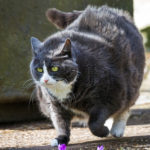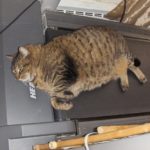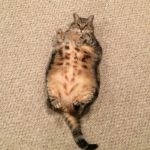


I have a confession; a dirty little secret as a veterinarian. I think fat cats are adorable. There, I said it! On the surface, I think they are adorable and cute. But in reality, when I see an obese cat my heart breaks for them because I know the multiple serious health risks that accompany our overweight cats. This article is going to focus on tips for cats to lose weight.
Ideal weight or body condition is scored on a 9 point scale. During your cats exam, your veterinarian can assess your pet’s body condition score based on his silhouette and how much fat is located in certain areas. Based on this, her ideal weight can be determined.
What Are the Health Risks for Overweight Cats?
The major health risks to overweight cats include skin issues, diabetes mellitus, and joint pain. Obesity in cats does not increase their risk to getting arthritis, that we know of, or heart disease, etc. But being overweight will exacerbate pre-existing conditions such as risk of death associated with heart disease and pain from degenerative joint disease.
Skin issues are very common in overweight cats. Grooming is important for removing dead skin cells, untangling fur, and distributing natural oils evenly on the skin. A less palatable function of grooming in animals is also keeping feces and urine buildup in their peri-rectal areas. Cats that are overweight or obese often cannot reach their lower back, hips, and private areas. Pet care givers will often notice that their overweight pet has a dull coat or lots of dry white flakes over their back and occasionally a greasy, unkempt look. Matts can easily grow in size and can be irritating and painful as they become tighter near the skin. Matting can also cause skin infections. Buildup of urine and feces can cause skin infections and secondary urinary tract infections.
Obesity is a major risk for cats developing diabetes
mellitus. Some studies show that approximately
50-60% of diabetic cats are overweight. Diabetes mellitus (DM) is caused by not
enough insulin in the body. Insulin is critical for processing
sugars/carbohydrates and allowing the body to access those nutrients as
energy. Most pet caregivers are familiar
with DM in humans. In cats, they
typically have type II diabetes where the body makes some insulin, but not
enough. Excessive fat causes insulin
resistance, meaning the insulin that is produced, doesn’t work. This leads to high blood sugar and subsequent
deleterious effects. This risk factor
alone is enough to use some of the tips to get your cat to lose weight.
Increased body mass causes increased joint pain. Being overweight doesn’t necessary directly
cause arthritis. However, more weight increases
stress on the joints and therefore compounds joint pain that already exists. To learn more about arthritis and joint pain
in cats by clicking here.
Last, and something that is not thought of as often, are anesthetic risks. Obese animals pose an increased anesthetic risk. This has to do with altered metabolism of sedatives and anesthetic agents and decreased lung space. Excessive fat changes how certain drugs are metabolized. Abdominal fat presses against the diaphragm decreasing the total lung space your pet has to take in oxygen while being sedated. If your cat is obese, it would likely be best use some tips for weight loss before any elective procedures.
The good news is that obesity is preventable and reversible. The best tip is to avoid letting your cat become obese. But if your pet is already overweight, hopefully you can use some of these tips for your cat to lose weight.
Tips For Cats to Lose Weight
The first tip is to go slow. For your cat to safely lose weight, it needs to happen slowly. This equates to 0.5-1.5% of their body weight per week. It is important that they do not lose weight too quickly, as we do not want your cat missing out on any important nutrients that may lead to other problems, such as hepatic lipidosis (fatty liver disease).
Decrease Calories
Decrease calories.
The first step is to decrease total calories. If you are “free feeding” (filling a bowl and
letting her cat eat until it’s empty then filling again), try feeding several
small measured meals in 1 day. For
example, if you cat should have 200 Kcal per day and your pet’s food has 400
Kcal per cup, that means the TOTAL amount of this food he can get is ½ C a
day. If you feed treats and canned food
as well, this would be even less. Be
sure to look at the calories on the can and bags of food/treats and calculate
the volume your pet can get in a day. Multiple
cats in the house? Then you need to do
scheduled feedings.
Scheduled feedings means you feed a set amount of food, say ¼
C twice a day. To get your furlings used
to this, you set the food out in the morning, give them 20 minutes to eat
it. What isn’t eaten, gets put
away. Then when you come home in the
evening, offer another ¼ cup. They should
be hungry at this point at eat the whole thing in 15-20 minutes. Of course if
your schedule allows, you can and 1/8 of a cup 4 times a day if you wish. But remember, no more than your pet’s
calculated max (say 200 Kcal) in a day.
Exercise
Exercise. Figure
out what your cat likes and start small.
If she likes feather toys, play for 5 minutes at a time, several times a
day. Work up to longer duration. But maybe you find your cat pretty much hates
everything but napping, eating and being petted. You can take his kibble and placed it around
the house: on a chair, a cat tree, bookshelf, etc. I try and do this for our cats, but we have a
little dog who regularly sabotages my efforts.
Therefore, I need to make sure all the hidden food places are up high! You might have to be creative too. The point of this is that your cat will have
to walk around and find his food. Not only is this good to increase activity,
but it is also mentally stimulating. There
are also many food dispensing toys on the market.
If you’re still having trouble getting your cat moving, a
rehabilitation center may be a good option for your cat. They use water tread mills (yes, on your cat!),
balance balls, dry treadmills, etc.
Canned food
Canned food. Cats tend to lose weight more easily on canned food vs dry food. Canned food has a higher water content, which is better for cats in general. It is also easier to find canned foods that are higher in protein and lower in carbohydrates.
Most cat foods are much to high in carbohydrates. Unlike dogs, cats are obligate or true
carnivores. They need lots of animal protein
(not pea or legumes). Look for foods
that are:
- High in protein: over 40% of calories
- Moderate fat: less than 50% calories
- Low in carbohydrates: less than 10%
- High in water
Beware the canned foods with “gravy” as these typically increase the carbohydrate content of the foods. Some over the counter foods with generally good profiles are: Fancy Feast Classics Pate (not all flavors), Friskies Classic Pate, Tika Puka Puka Luau. Cat info.org has done a wonderful job making a nutritional spread sheet of canned foods on the market.
If you still feel like your having trouble getting your cat
to lose weight with over-the-counter diets, contact your veterinarian regarding
some prescription diets like Science Diet Metabolic (you can free feed this
food!!!!), Purina Pro Plan OM, and Purina Pro Plan DM dry or wet (loaf
style).
The Take Home Message
Overweight cats are at greater health risks than those pets
that are a normal body condition score. There are many tips you can try to help
your cat lose weight. We welcome any of
you who have had success getting our cat to lose weight, post some of your tips
and tricks below! If you have questions, ask your veterinarian.
